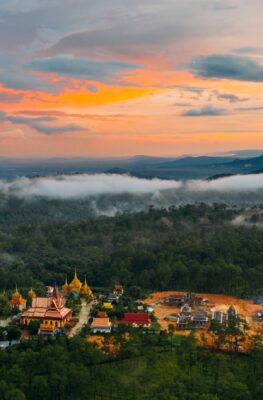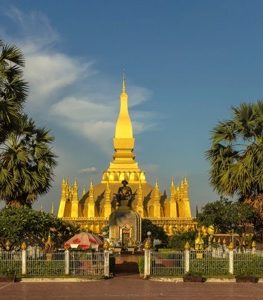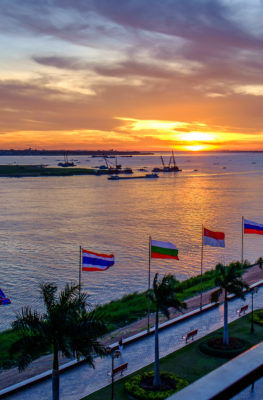Published on January 9, 2018
Prasat Banteay Kdei, Angkor Archaeological Park, Cambodia. Mike Aquino, used with permission.
Singaporean photographer and travel writer Jeremy Goh Guo-Huajoins us for a guest post that recreatest the zenith of Southeast Asia’s greatest historical empire. Check out Jeremy’s writing (and photography) at Asia361. Follow Jeremy’s work at Trippin’ Creatives website, or visit their social media profiles on Facebook, Twitter, Instagram and Youtube.
The rulers of the mighty Khmer empire forged the golden age of civilisation on mainland Southeast Asia, one that lasted from the 8th until the 14th century. At its zenith, the Khmer Devaraja (deified kings) presided over a kingdom that covered a wide swath of today’s Southeast Asia, even as its influence extended further beyond.
The Angkorian temples in the Angkor Archaeological Park, especially the haunting faces of the Bayon, are the Khmer Empire’s most easily identifiable and iconic remains. However, through a reign lasting over 600 years, they also left behind many more imposing and inspiring monuments outside the plains of Siem Reap.
A Broad Network of Cities
Cambodia, Thailand, Laos, the Mekong delta of Vietnam and a fragment of lower Myanmar were all part of the contiguous Khmer empire.
Major roads fanned out from the capital at Angkor and linked the major period cities of Phimai, Wat Phu, Sambor Prei Kuk, Preah Vihear and others. Along the way, rest houses, “libraries” and “hospital-chapels” were the amenities that travellers relied on while on their journey.
In modern day Cambodia, impressive megalithic structures can be found in almost every direction:
Koh Ker lies 100km northwest of Angkor, in a remote and densely forested part of the country. The complex consists of many isolated towers and temples, dominated by the uniquely shaped Prasat Thom that earned it a UNESCO listing. Its square-based, pyramidal structure resembles Mesoamerican Mayan structures half a world away.
Banteay Chhmar. Mike Aquino, used with permission.
Banteay Chhmar is a massive site contemporaneous with Angkor but sparsely visited or maintained. Not yet having attained UNESCO status, a large portion of the central structure lies in a messy jumble of fallen stone slabs.
Despite this, Banteay Chhmar’s remaining structures will leave the visitor awestruck. The enormous smiling face towers called Bayon, synonymous with Angkor, are also found here. Several archaeologically important and dramatically large bas reliefs are found here, such as the one depicting a war raid and another of a multiple-armed deity.
It’s a three-hour drive northwest from Siem Reap – too far for a day trip, but ideal for a glamping stay in the nearby town, or at the temple itself.
Prasat Preah Vihear sits on top of a mountain cliff on the Dângrêk Mountains near the Thai-Cambodian border. After a border dispute from 2008 till 2013, both Thailand and Cambodia have come to an agreement over the temple’s location, and tourists can now freely see the fantastic views from the temple’s mountaintop perch.
Sambor Prei Kuk, another UNESCO site, is located 180km east of Angkor. The site predates Angkor by many centuries and served as a model for later temples. Its octagonal temples are its most conspicuously unique feature, and its extensive collection of stone lions, lintel carvings and massive root covered towers increase its visual appeal.
Phimai Historical Park, Nakhon Ratchasima. Image courtesy of the Tourism Authority of Thailand.
Khmer Ruins in Thailand
Thailand, has the largest collection of Khmer temples and structures outside Cambodia, with most of them to be found in the Northeastern provinces.
Phimai’s most important legacy is as its role as the Western terminus of the ancient Angkor road. It is also known for being the largest and most majestic of all the Khmer temples in Thailand.
Buriram is also found along the Angkor road. The area includes Phanom Rung, Wat Khao Angkhan and Muang Tum, all of which were constructed on top of an extinct volcano. In the 9th and 10th centuries, the area produced ceramics, and remains of the Angkorian era kilns can be found at several sites here.
Ku Ka Sing Temple, Roi Et. Image courtesy of the Tourism Authority of Thailand.
The temples of Ku Ka Sing, close to Roi Et City, consists of 3 towers built on a laterite platform. There are several well-preserved lintel carvings here, and the modern temple next door maintains the site meticulously.
Unlike other historical Khmer temple sites in Thailand, Ku Ka Sing is less crowded – all the better to contemplate on the local empires, dynasty and history.
Wat Phou, Laos. James Antrobus/Creative Commons
Khmer Ruins in Laos & Vietnam
The history of Laos and Vietnam intimately intertwines with Cambodia’s. Long ago, present-day Ho Chi Minh City was called Prey Nokor and stood within the Khmer sphere of influence. To this day, large populations of ethnic Khmers reside in Vietnam’s Mekong delta. Architecturally, Laos and Vietnam share vestiges of its past Khmer rulers.
Wat Phou is the premier Khmer temple attraction in Laos. The main temple is built halfway up Phou Khao mountain, while the remaining structures are laid out lengthwise towards the plains and onward to the ancient, south-facing road that led to Angkor.
At the uppermost level, a stone carving in the shape of a crocodile is postulated to have served as a sacrificial altar.
Vinh Hung (Luc Hien or Bhah Dhat tower) in Bac Lieu, is Vietnam’s only Khmer ruin, although the country has many other constructions by its rivals, the Chams. All that remains of the site is a single tower, cleaved open by time and the elements. Inside the tower, a hand made of bronze, part of a goddess statue, a stone goddess statue, heads of Buddha and Brahma God heads, and other religious objects were found. The ruin is still a functioning religious site and monks come to chant scriptures twice a day at 4 o’clock in the morning and afternoon.
Many travelers, academics and romantics have been enthralled by the stories of the Khmer empire. It is easy to see why. One could easily spend a lifetime visiting and turning over every stone and not fully unlock the mysteries they present.





